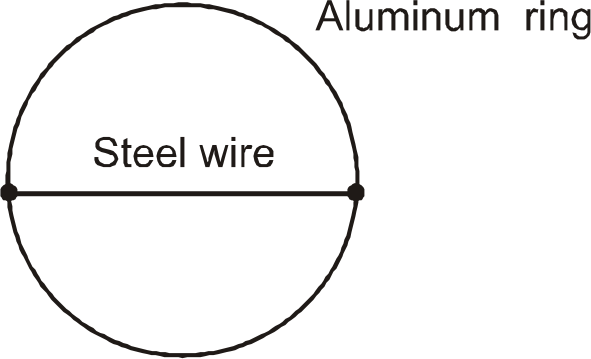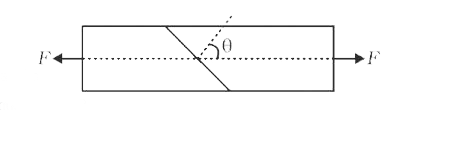What is thermal stress?
Step-by-Step Solution:
1. Definition of Thermal Stress:
- Thermal stress is defined as the stress that develops in a material due to a change in temperature. When the temperature of a material changes, it tends to expand or contract. If the material is constrained (e.g., fixed at both ends), this expansion or contraction cannot occur freely, leading to the development of stress.
2. Consider a Rod:
- Imagine a rod that is fixed at both ends (rigid support). Let’s denote the initial length of the rod as L.
3. Temperature Change:
- When the temperature of the rod increases by ΔT, the rod will attempt to expand. The amount of expansion (deformation) can be represented as ΔL.
4. Expansion Calculation:
- The deformation ΔL due to the temperature change can be calculated using the formula:
ΔL=L⋅α⋅ΔT
where α is the coefficient of thermal expansion of the material.
5. Understanding Strain:
- Strain is defined as the ratio of deformation to the original length. Therefore, the thermal strain ϵ can be expressed as:
ϵ=ΔLL=L⋅α⋅ΔTL=α⋅ΔT
6. Stress and Modulus of Elasticity:
- The relationship between stress (σ), strain (ϵ), and the modulus of elasticity (E) is given by:
E=σϵ
Rearranging this gives:
σ=E⋅ϵ
7. Calculating Thermal Stress:
- Substituting the expression for thermal strain into the equation for stress, we find:
σ=E⋅(α⋅ΔT)
Thus, the thermal stress can be expressed as:
Thermal Stress=E⋅α⋅ΔT
8. Conclusion:
- Therefore, thermal stress is directly proportional to the modulus of elasticity, the coefficient of thermal expansion, and the change in temperature.
---
- Thermal stress is defined as the stress that develops in a material due to a change in temperature. When the temperature of a material changes, it tends to expand or contract. If the material is constrained (e.g., fixed at both ends), this expansion or contraction cannot occur freely, leading to the development of stress.
- Imagine a rod that is fixed at both ends (rigid support). Let’s denote the initial length of the rod as L.
- When the temperature of the rod increases by ΔT, the rod will attempt to expand. The amount of expansion (deformation) can be represented as ΔL.
- The deformation ΔL due to the temperature change can be calculated using the formula:
ΔL=L⋅α⋅ΔT
where α is the coefficient of thermal expansion of the material.
- Strain is defined as the ratio of deformation to the original length. Therefore, the thermal strain ϵ can be expressed as:
ϵ=ΔLL=L⋅α⋅ΔTL=α⋅ΔT
- The relationship between stress (σ), strain (ϵ), and the modulus of elasticity (E) is given by:
E=σϵ
Rearranging this gives:
σ=E⋅ϵ
- Substituting the expression for thermal strain into the equation for stress, we find:
σ=E⋅(α⋅ΔT)
Thus, the thermal stress can be expressed as:
Thermal Stress=E⋅α⋅ΔT
- Therefore, thermal stress is directly proportional to the modulus of elasticity, the coefficient of thermal expansion, and the change in temperature.
Topper's Solved these Questions
- PROPERTIES OF MATTERBOOK - ICSECHAPTER - PROPERTIES OF MATTEREXERCISE - MODULE 1 (ELASTICITY)VERY SHORT ANSWER QUESTIONS
8 Videos
- PROPERTIES OF MATTERBOOK - ICSECHAPTER - PROPERTIES OF MATTEREXERCISE - MODULE 1 (ELASTICITY)FROM YOUNG.S MODULUS
19 Videos
- PROPERTIES OF MATTERBOOK - ICSECHAPTER - PROPERTIES OF MATTEREXERCISE - MODULE 1 (ELASTICITY)LONG ANSWER QUESTIONS
5 Videos
- OSCILLATIONS BOOK - ICSECHAPTER - OSCILLATIONS EXERCISE - SELECTED PROBLEMS (OSCILLATION IN A TUNNEL BORED THROUGH THE EARTH)
2 Videos
- SAMPLE QUESTION PAPER - 01 BOOK - ICSECHAPTER - SAMPLE QUESTION PAPER - 01 EXERCISE - SECTION - D
12 Videos
Similar Questions

A steel wire is rigidly fixed along diameter of aluminium ring of radius R as shown. Linear expansion coefficient of steel is half of linear expansion coefficient for aluminium thent he thermal stress developed in steel wire is:
View SolutionThe increase of length of a wire under a load is equal to its initial length. What is the stress in the wire equal to?
View SolutionSTATEMENT - 1 : When a rod lying freely is heated, no thermal stress is developed in it.
and
STATEMENT - 2 : On heating, the length of the rod increase.
View SolutionWhat will be the stress required to double the length of a wire of Young's modulus Y?
View SolutionA rod of aluminium is fixed between two rigid support. If the temperature of rod is increased by 10°C, then the thermal stress on the rod is (Take Y=7×1010Pa and α=2.4*10−5K−1)
View SolutionWhat is a stress hormone ? Or The hormone produced during adverse environmental conditions is
View SolutionA bar of cross section A is subjected to equal and opposite tensile force at its ends. Consider a plane section of the bar whose normal makes an angle θ with the axis of the bar.

a. What is the tensile stress on the plane?
b. What is the shearing stress on the this plane?
c. For what value of θ is the tensile stress maximum?
d. For what value of θ is the shearing stress maximum?
View SolutionA bar of cross-section A is subjected to equal and opposite tensile forces at its ends. Consider a plane section of the bar whose normal makes an angle θ with the axis of the bar .
(i) What is the tensile stress on this plane?
(ii) What is the shearing stress on this plane?
(iii) For what value of θ is the tensile stress maximum
(iv) For what value of θ is the shearing stress maximum?

View SolutionThe ratio of thermal conductivites of two different metals is 5:3. In order to have the same thermal resistance in these metals of equal thickness what should be the ratio of their length?
View SolutionWrite the dimensional formul of Thermal stress.
View Solution
